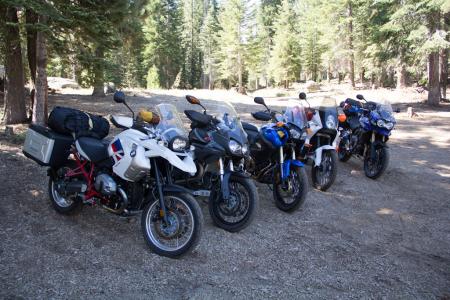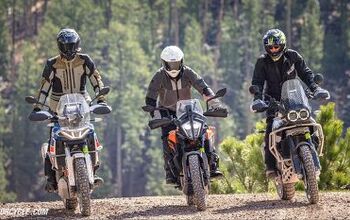2012 Adventure-Touring Shootout - Video - Motorcycle.com
BMW’s R1200GS has long been the cock of the walk when it comes to big-bore Adventure-Touring bikes, but with unit sales in the A-T segment increasing by double-digit percentages (the most of any class of motorcycles in the U.S.), OEMs, like wily hedge fund managers, are buying into the sector.
The Triumph Explorer and Yamaha Super Ténéré are the newest combatants in this increasingly competitive market, while both KTM and Moto Guzzi have held positions in this category with models of their own, shall we say, eccentricities. What these five bikes represent, though, are the disparate avenues manufacturers are traveling to attain a similar goal. Which begs the question: Have any of these Johnny-come-lately A-T bikes succeeded in surpassing the mighty GS to become the new benchmark model?
Achieving the answer to that question was fraught with scorching temperatures and mind-numbing freeway miles, but also ribbony two-laners, gravelly fire roads and dusty singletracks, all the while loaded down with an assortment of clothing and camping gear. Sentiments ranged from surprised to disparaged, and in the end consensus, but not absolute agreement.
From the most expensive base model MSRP, BMW at $16,149, to the least expensive, Yamaha at $14,899, the bikes are all within a $1,700 price range. Because of its least expensive price, the Ténéré scored a perfect 100% in the Price/Value category of our ScoreCard, with the KTM coming in a close second. Each manufacturer produces an array of accessories to outfit their model which increases the price you’ll pay accordingly, but BMW, with its longevity in this category, is backed by the strongest selection of accessory components.
| Five Adventure-Tourers | |||
| Model | MSRP | MPG | Range |
| BMW R1200GS | $16,149 (19,045.00 Rally Edition) | 32.5 | 172 miles |
| KTM Adventure 990 | $14,899 | 33.1 | 175 miles |
| Moto Guzzi Stelvio NTX | $15,990 | 36.6 | 311 miles |
| Triumph Tiger Explorer | $15,699 | 35.1 | 186 miles |
| Yamaha Super Ténéré | $14,499 | 39.4 | 236 miles |
Of special interest is the fact that engine configuration among these five motorcycles is never duplicated. Besides Triumph’s inline-Triple, Twins are the cylinder count of choice, but their arrangement varies from opposed to parallel and from inline-V to transverse-V. So, unlike testing a brood of Japanese 600cc supersports with nearly identical inline four-cylinders, each bike here presents unique engine characteristics.
With 1215cc and 111.7 horsepower the Triumph Explorer boasts the greatest displacement and peak horsepower among this group. “The engine is very strong, with a ton of stomp,” notes editor-at-large, Troy Siahaan. And besides Guzzi (whose graph resembles a sound wave more than a torque curve) with its 74.9 ft-lb of torque, the Triumph also exhibits the best torque figure (74.6 ft-lb). But it’s not the peak torque that’s impressive, it’s the ability of the Explorer engine to deliver 60+ ft-lb of torque beginning at 2500 rpm and continuing all the way to 9300 rpm.
It shouldn’t be surprising to learn that the Triumph earned a category-winning 92.5% among all testers in the Engine section on the Adventure-Touring ScoreCard. What did raise some eyebrows was third-place finisher, KTM’s Adventure model and its smallest-of-the-bunch 999cc V-Twin with a score of 71.25%.
“Although it’s out-cubed by the other engines in this group, its responsiveness due to the Adventure’s light weight makes one wonder about the need to go bigger,” says Chief Editor, Kevin Duke.
BMW’s Boxer engine (it and the Guzzi being the only two air-cooled models) took second-place honors with a score of 80%. “I thought the BMW engine would get outclassed, but it held its own just fine,” says Siahaan, “it stayed right with the Triumph during sixth gear roll-ons!”
Leaving the Ténéré and Stelvio fighting to not be last, it was our second surprise to learn that the Guzzi narrowly defeated the Yamaha by a scant margin of 1.25% (66.25% vs 65%). “It’s not fast, but the Guzzi’s 90-degree V-Twin grunts like a John Deere 9400,” says guest tester Dean Hight.
Owning the lowest engine score of the group the Ténéré was repeatedly condemned by testers with words such as “neutered,” “uninspiring” and “lacking character.” It’s especially disappointing that a fresh liquid-cooled, double-overhead-cam design can’t match the grunt from BMW’s air-cooled Boxer motor, a powerplant that surely must’ve been benchmarked while the Ténéré was being developed.
Hight sums up our general opinion saying, “Where the Guzzi is slow and torquey, the Yamaha is just slow.”
But don’t jump the gun assuming the Yamaha loses this shootout just because of its subpar engine performance. There’s a lot more to this comparison where the Ténéré exacts retribution and the early leader Triumph falters under pressure from our testers.
More by Tom Roderick































Comments
Join the conversation